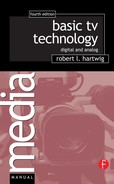A computer can only deal with one of two valuse
An Introduction to Digital (2)
Bits and Bytes — Binary Numbering System
The smallest part of the computer's memory is called a bit. It either has an electrical charge or it doesn't. If the bit has no charge, it is represented by the number 0; if the bit has a charge it is represented by the number 1. That's it! That's all computers can deal with: 0s and 1s. As you can see, a 0 or a 1 isn't much information. So in order to have a segment of memory that we can use effectively, we have to combine numbers of bits together into a unit that is called a byte. In 8-bit processing we would combine 8 bits. In 10-bit processing we could combine 10 bits and so on.
Let's look at 8-bit processing since that is what is used in the home computers familiar to you. Since each bit has only two possibilities, 0 or 1, when we combine two bits together we have four possibilities: 00, 01, 10, or 11. When we combine 8 bits together, we have 256 possibilities (28 or 2 multiplied by itself 8 times: 2 x 2 x 2 x 2 x 2 x 2 x 2 x 2 = 256). With 10-bit processing you would add 2 more bits to the process and get 1024 possible combinations. With the 256 combinations of 8-bit processing, we can assign one specific combination to represent the capital letter “A” and a different specific combination to represent the small letter “a.” We can do the same thing for the letters “B,” “C,” “D,” and so on. We can also use specific combinations to represent punctuation marks, the numbers 0 through 9, mathematical symbols, and so on. The software, the computer's program, tells the computer how to use that information. “Treat this specific byte combination like it is the letter ‘A’ in the alphabet.” The byte, then, is the smallest segment of memory that can be used as a piece of information: a letter or a digit or a punctuation mark or such.
So no matter what a computer may seem to be doing — surfing the web, writing a paper for class, or creating wild video images — what it is really doing is manipulating numbers (0s and 1s).
1. Bits.
2. Bytes (8-bit processing)

